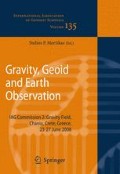Abstract
GRACE-derived geoid rates are studied for North-America, where the adjustment of the Earth to ancient ice sheets causes a secular geoid increase up to 1.3 mm/year. These significant geoid changes are of particular interest for establishing a new geoid-based vertical datum in Canada and other high accuracy applications. To quantify the uncertainty of the derived rate of change of the geoid, several methods for GRACE error approximation are studied using: (i) calibrated standard deviations, (ii) a full covariance matrix, and (iii) residuals of least-squares fit of a trend and periodic variations to the time series of spectral coefficients. It is found that the residuals give the largest error estimates, probably because correlated errors are captured better. Furthermore, through maximizing the signal-to-noise ratio, it is found that the Swenson and Wahr (2006) filter of correlated GRACE errors should be applied to coefficients above degree 22 and order 4. Measurement errors are largely longitude independent, with magnitude around 0.06 mm/year. The largest geoid rate uncertainty is estimated in the area of present-day ice melt in Alaska and south of the Great Lakes and south-west of Hudson Bay (over 0.3 mm/year) due to uncertainty in continental water storage. For the creation of a geoid rate model based on GRACE data it is important that efforts are focused on reducing uncertainty in these areas, rather than improving post-processing.
Access this chapter
Tax calculation will be finalised at checkout
Purchases are for personal use only
References
Ågren, J. and R. Svensson (2007). System definition and postglacial land uplift model for the new Swedish height system RH 2000. Lantmäteriet, Rapportserie: Geodesi och Geografiska informationssystem, 2006:X (in print), Gävle.
Bettadpur, S. (2008). GRACE: Progress towards product improvement, and prospects for synergy with GOCE, 2008. Oral presentation, GGEO 2008 Symposium, June 23–27, Chania, Crete, Greece.
Döll, P., F. Kaspar, and B., Lehner (2003). A global hydrological model for deriving water availability indicators: model tuning and validation. J. Hydrol., 270, 105–134.
Hunger, M. and P. Döll (2008). Value of river discharge data for global-scale hydrological modeling. Hydrol. Earth Syst. Sci., 12, 841–861.
Luthcke, S., A. Arendt, D. Rowlands, J. McCarthy, and C. Larsen (2008). Recent glacier mass changes in the Gulf of Alaska region from GRACE mascon solutions. J. Glaciol., 54(188), 767–777.
Milly, P.C.D. and A.B. Shmakin (2002). Global modeling of land water and energy balances, part I: The land dynamics (LaD) model. J. Hydrometeorol., 3(3), 283–299.
Rangelova, E. (2007). A dynamic vertical datum for Canada. PhD thesis, Dept. of Geomatics Engineering, University of Calgary.
Rangelova, E. and M.G. Sideris (2008). Contributions of terrestrial and GRACE data to the study of the secular geoid changes in North America. J. Geodyn., 46, 131–143, doi:10.1016/j.jog.2008.03.006.
Rangelova, E., W. van der Wal, M.G. Sideris, and P. Wu (2008). Spatiotemporal analysis of the GRACE-derived mass variations in North America by means of multi-channel singular spectrum analysis, GGEO 2008 Symposium, June 23–27, accepted for proceedings.
Rodell, M., P.R. Houser, U. Jambor, J. Gottschalck, K. Mitchell, C.-J. Meng, K. Arsenault, B. Cosgrove, J. Radakovich, M. Bosilovich, J.K. Entin, J.P. Walker, D. Lohmann, and D. Toll (2004). The global land data assimilation system. Bull. Am. Meteorol. Soc., 85(3), 381–394.
Steffen, H., H. Denker, and J. Müller (2008). Glacial isostatic adjustment in Fennoscandia from GRACE data and comparison with geodynamical models. J. Geodyn., 46, 155–164.
Swenson, S., D. Chambers, and J. Wahr (2008). Estimating geocenter variations from a combination of GRACE and ocean model output. J. Geophys. Res., 113, doi:10.1029/2007JB005338.
Swenson, S. and J. Wahr (2006). Post-processing removal of correlated errors in GRACE data. Geophys. Res. Lett., 33, L08402, doi:10.1029/2005GL025285.
Tamisiea, M.E., J.X. Mitrovica, and J.L. Davis (2007). GRACE Gravity data constrain ancient ice geometries and continental dynamics over Laurentia. Science, 316, 881–883.
Tushingham, A.M. and W.R. Peltier (1991). ICE-3G: A new global model of late Pleistocene deglacation based upon geophysical predictions of post-glacial relative sea level change. J. Geophys. Res., 96(B3), 4497–4523.
Van der Wal, W., P. Wu, M.G. Sideris, and C.K. Shum (2008). Use of GRACE determined secular gravity rates for glacial isostatic adjustment studies in North-America. J. Geodyn., 46, 144–155, doi:10.1016/j.jog.2008.03.007.
Velicogna, I. and J. Wahr (2002). Postglacial rebound and Earth’s viscosity structure from GRACE. J. Geophys. Res., 107(B12), doi: 10.1029/2001JB001735.
Wahr, J., S. Swenson, and I. Velicogna (2006). Accuracy of GRACE mass estimates. Geophys. Res. Lett., 33, doi: 10.1029/2005GL025305.
Wahr, J., S. Swenson, V. Zlotnicki, and I. Velicogna (2004). Time-variable gravity from GRACE: First results. Geophys. Res. Lett., 31, L11501, doi:10.1029/2004GL019779.
Witze, A. (2008). Climate change: losing Greenland. Nature, 452, 798–802, doi:10.1038/452798a.
Acknowledgements
We thank the two anynomous reviewers for their comments, John Ries and Srinivas Bettadpur of CSR Texas for providing sample covariance matrices and for discussion, John Wahr, Holger Steffen and Balaji Devaraju for discussion and advice for GRACE data analysis, Kristina Fiedler and Petra Döll for providing the WGHM model output, Chris Milly for making available the LaD model output and Matt Rodell for making available the GLDAS model output. Financial support has been provided by NSERC and GEOIDE NCE grants to Drs. Sideris and Wu.
Author information
Authors and Affiliations
Corresponding author
Editor information
Editors and Affiliations
Rights and permissions
Copyright information
© 2010 Springer-Verlag Berlin Heidelberg
About this paper
Cite this paper
van der Wal, W., Rangelova, E., Sideris, M., Wu, P. (2010). Secular Geoid Rate from GRACE for Vertical Datum Modernization. In: Mertikas, S. (eds) Gravity, Geoid and Earth Observation. International Association of Geodesy Symposia, vol 135. Springer, Berlin, Heidelberg. https://doi.org/10.1007/978-3-642-10634-7_81
Download citation
DOI: https://doi.org/10.1007/978-3-642-10634-7_81
Published:
Publisher Name: Springer, Berlin, Heidelberg
Print ISBN: 978-3-642-10633-0
Online ISBN: 978-3-642-10634-7
eBook Packages: Earth and Environmental ScienceEarth and Environmental Science (R0)

